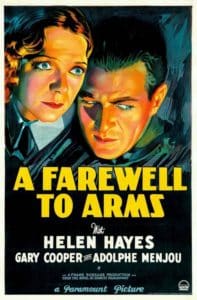Critics usually describe Hemingway’s style as simple, spare, and journalistic. These are all good words; they all apply. Perhaps because of his training as a newspaperman, Hemingway is a master of the declarative, subject-verb-object sentence. His writing has been likened to a boxer’s punches–combinations of lefts and rights coming at us without pause. Take the following passage:
We were all cooked. The thing was not to recognize it. The last country to realize they were cooked would win the war. We had another drink. Was I on somebody’s staff? No. He was. It was all balls.
The style gains power because it is so full of sensory detail.
There was an inn in the trees at the Bains de l’Allaiz where the woodcutters stopped to drink, and we sat inside warmed by the stove and drank hot red wine with spices and lemon in it. They called it gluhwein and it was a good thing to warm you and to celebrate with. The inn was dark and smoky inside and afterward when you went out the cold air came sharply into your lungs and numbed the edge of your nose as you inhaled.
The simplicity and the sensory richness flow directly from Hemingway’s and his characters’ beliefs. The punchy, vivid language has the immediacy of a news bulletin: these are facts, Hemingway is telling us, and they can’t be ignored. And just as Frederic Henry comes to distrust abstractions like “patriotism,” so does Hemingway distrust them. Instead, he seeks the concrete, the tangible: “hot red wine with spices, cold air that numbs your nose.” A simple “good” becomes higher praise than another writer’s string of decorative adjectives.
Though Hemingway is best known for the tough simplicity of style seen in the first passage cited above, if we take a close look at A Farewell to Arms, we will often find another Hemingway at work–a writer who is aiming for certain complex effects, who is experimenting with language, and who is often self-consciously manipulating words. Some sentences are clause-filled and eighty or more words long. Take for example the description in Chapter 1 that begins, “There were mists over the river and clouds on the mountain”; it paints the entire dreary wartime autumn and foreshadows the deaths not only of many of the soldiers but of Catherine.
Hemingway’s style changes, too, when it reflects his characters’ changing states of mind. Writing from Frederic Henry’s point of view, he sometimes uses a modified stream-of-consciousness technique, a method for spilling out on paper the inner thoughts of a character. Usually, Henry’s thoughts are choppy, staccato, but when he becomes drunk the language does too, as in the passage in Chapter 3.
I had gone to no such place but to the smoke of cafes and nights when the room whirled and you needed to look at the wall to make it stop, nights in bed, drunk, when you knew that that was all there was, and the strange excitement of waking and not knowing who it was with you, and the world all unreal in the dark and so exciting that you must resume again unknowing and not caring in the night, sure that this was all and all and all and not caring.
The rhythm, the repetition, has us reeling with Henry. Thus, Hemingway’s prose is in fact an instrument finely tuned to reflect his characters and their world. As we read A Farewell to Arms, we must try to understand the thoughts and feelings Hemingway seeks to inspire in us by the way he uses language.


Awesome work. It helped me a lot. Thanks dear.